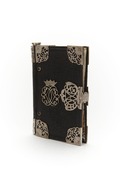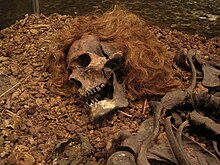GLAM/Newsletter/November 2014/Contents/Sweden report
|
Use, reuse and contributions back and forth
Swedish empire edit-a-thon

On november 5th an edit-a-thon on the topic Swedish Empire took place at the Vasa museum in Stockholm. The edit-a-thon was a collaboration between the Vasa museum, The Royal Armoury, Skokloster Castle and the Hallwyl museum, in project GLAM. During the day several articles about the Swedish Empire were written, updated and extended by the participants, and no less than six lectures on different topics related to the Swedish Empire – such as the Swedish Empire from a gender perspective, were given. We were also given a tour of the exhibition meanwhile, where the touch table was demonstrated. With more than thirty participants, and at least as many new or extended articles, the edit-a-thon was definitely a success.
A new batch upload

About a year ago, we at the Swedish museums The Royal Armoury, Skokloster Castle and the Hallwyl museum took an important step towards increased openness when we made 20 000 high-resolution images available on Wikimedia Commons. Since then we have photographed 6000 new objects, amongst others the collection of rifles at Skokloster castle, and now they are uploaded to Commons! One of the many benefits of the contribution to Wikimedia Commons is the increased reach of our images, nationally as well as internationally. The possibility of creating links between images, people and historic events enriches information about the museums’ collections. Since the first upload our images have been viewed more than 2.7 million times, and we are so happy that we are able to share the images of the treasures that the museums hold, and to make them available for everyone to use. Thanks to the new report page created by Fæ we can also se the use of images, popular categories and users who help improve the collection.
Metadata for Europeana
Last month we reported on the work done on exporting metadata about collections on Commons to Europeana. Now the first dataset is live showing the images from our Då&Nu competition and illustrating how the images are connected to other Europeana objects. This is a small dataset, only 59 images. But during December the 14,000 Wiki Loves Monuments in Sweden images will also go live. If you are interested in putting together your own export the code is available on GitHub and André at Wikimedia Sverige will be happy to help if you have any questions.
Donation of source code
After reuseing images and articles from Commons and Wikipedia in the Samtidigt/Meanwhile exhibition, The Vasa museum also made material available as they released the source code for the touch table connected to Wikipedia. While having the intention from the start the museum had to accepet a new policy as this was the first time they released code under a free license. The code is available at the GitHub account created by Statens maritima museer. So far the program is adapted to the Samsung SUR40 touch table running Microsoft Windows, but as it is now under a MIT license anyone can modify the code to use it with other hardware and with other categories then the ones between 1600 and 1650 that The Vasa museum populated tha table with. A new film showing how the table works is available at Youtube and was also shown at the Zugang gestalten conference in Berlin 13-14 November.
Hackathon

The 2014 Amsterdam Hackathon took place in November and was focused on GLAM activities and Wikidata. The Swedish effort focused on two projects aiming to bring GLAM data to Wikidata.
The first was to create items for the remaining paintings in the collections of the Nationalmuesum in Sweden. This was done using the data made available through Europeana and was part of the Sum of all paintings project. The end result is approximately 4,500 imported paintings. There is still more work needed to connect paintings with creators, images already on Commons. For the sub-collection from the National Portrait Gallery it would also be very interested to connect each painting with the person(s) being depicted.
The second project aimed to add and/or source statements about architects on Wikidata by making use of the dataset provided by the Swedish Centre for Architecture and Design (ArkDes). What makes this interesting is in part that ArkDes has already connected many of their architects to Wikidata items, and in part that the process aims to add sourcing statements even if the same statement is already present and already otherwise sourced. Since ArkDes is an authoritative source for this type of information, it signals that the given statement is more reliable.
Free Society Conference and Nordic Summit
Free Society Conference and Nordic Summit (FSCONS) is a conference focusing on everything open. Wikimedia Sverige had an own track and a booth. We gave talks and workshops on the Wikimedia API, how to collaborate with Wikimedia and translatewiki.net.
Working with the web in Varberg

At a conference in Varberg on how to work with cultural heritage on the web organized by the National Heritage Board Axel Pettersson and Anna Frid (former employee at Hallands kulturhistoriska museum) gave a presentation about Bockstensmannen, and how a GLAM can work with the community when an article is hijacked by amature researchers with alternative theories. The Bocksten man is the remains of a man murdered in 1350-1370 and left with an oak pole through his heart. As he was lying in a bog the skeleton, hair and clothes were well preserved and are now on display at the museum. After a complete re-write by Anna Frid, with help from the community, the article was neutral and included all sides of the story with everything properly sourced. After she moved to a new job and lost touch with the article, alternative theories started to move in and take over again. A shared watchlist for the GLAM might help them keep a collective eye on both the Bocksten man and other articles they are intersted in.
#Socmus
IDEK is an organization doing things around cultural heritage and digital communication, such as running workshops, visiting museums and getting twitter discussions going using the hashtag #Socmus. Friday November 14 the #Socmus was dedicated to the topic Wikipedia and the relationship between GLAMs and the Open culture movement. During the two hour long discussion a lot or users talked about the benefits of using free licenses on material, how to get staff to contribute to articles on Wikipedia, strategies for getting released images both up to Commons and also to be used in articles and a lot more. This was the second Wikipedia #socmus, and the tweets are collected in a storify timeline. The previous one (from September 2013) can be found here.

